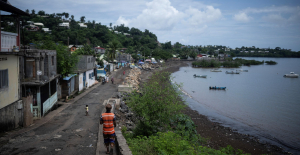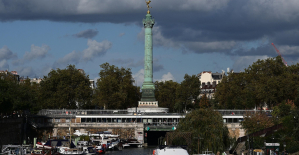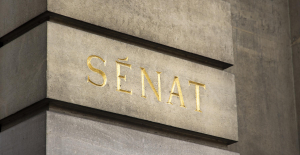Splendid frescoes representing, among other things, a striking mythological scene have been discovered in Pompeii, those responsible for the archaeological site located near Naples, in southern Italy, announced on Friday. It was restoration and excavation work that allowed “the discovery of these frescoes of great value” in and around the House of Leda, one of the residences of the ancient city of Pompeii, destroyed and buried under ashes in the year 79 by the eruption of Vesuvius.
The most striking is undoubtedly the one representing the mythological scene depicting Phrixos and his twin Hellé fleeing their stepmother Ino on the ram with the Golden Fleece. Phrixos, perched on the rearing ram, helplessly witnesses the fall of his unfortunate sister Hellé into the waters which they fly over on their mounts.
This “fresco which shows us two fugitives at sea from ancient Greece”, in the words of the director of Pompeii Gabriel Zuchtriegel, appears like a painting with its frame on a predominantly golden yellow wall decorated with delicate decorations.
Among the other frescoes discovered are still lifes and portraits of women, particularly in medallions. The current excavations at the Maison de Léda aim to reconstruct its complete plan and to collect sufficient information to determine the main rooms of two other residences located to the north and south of it.
Cleaning operations on the frescoes are underway to remove volcanic ash and consolidate them before moving on to the restoration phase. The volcanic ash spewed 2,000 years ago by Vesuvius sedimented on most of the homes of Pompeii, which allowed them to be almost completely preserved, as did many of the bodies of the 3,000 deaths caused by the catastrophe.
Listed as a UNESCO World Heritage Site, Pompeii, the second most visited tourist site in Italy after the Colosseum in Rome, covers a total area of approximately 22 hectares, a third of which is still buried under ashes.

 Gaza: under the spotlight, the Israeli-Palestinian conflict shakes up the Eurovision contest
Gaza: under the spotlight, the Israeli-Palestinian conflict shakes up the Eurovision contest Black soldier killed by a police officer in the United States: the sheriff publishes the video of the arrest
Black soldier killed by a police officer in the United States: the sheriff publishes the video of the arrest In Malmö, the Eurovision party transformed into entrenched camps
In Malmö, the Eurovision party transformed into entrenched camps In Russia, Vladimir Putin stigmatizes “Western elites”
In Russia, Vladimir Putin stigmatizes “Western elites” Fatal case of cholera in Mayotte: the epidemic is “contained”, assures the government
Fatal case of cholera in Mayotte: the epidemic is “contained”, assures the government The presence of blood in the urine, a warning sign of bladder cancer
The presence of blood in the urine, a warning sign of bladder cancer A baby whose mother smoked during pregnancy will age more quickly
A baby whose mother smoked during pregnancy will age more quickly The euro zone economy grows in April at its best pace in almost a year but inflationary pressure increases
The euro zone economy grows in April at its best pace in almost a year but inflationary pressure increases IBM, Amazon, Hager... These record investments expected at the Choose France summit
IBM, Amazon, Hager... These record investments expected at the Choose France summit Boeing's black streak: a second Air France flight diverted in three days for “a smell of heat”
Boeing's black streak: a second Air France flight diverted in three days for “a smell of heat” Tesla: demonstrators try to break into a factory in Germany
Tesla: demonstrators try to break into a factory in Germany Argentina: a second general strike in five months against Javier Milei
Argentina: a second general strike in five months against Javier Milei “I want to apologize”: Kendji Girac speaks for the first time since his injury
“I want to apologize”: Kendji Girac speaks for the first time since his injury Gollum at the heart of the next Lord of the Rings film and controversies
Gollum at the heart of the next Lord of the Rings film and controversies In Paris, the redevelopment of the squares between Bastille and the Saint-Martin canal displeases some residents
In Paris, the redevelopment of the squares between Bastille and the Saint-Martin canal displeases some residents Cate Blanchett in majesty at the San Sebastian Festival
Cate Blanchett in majesty at the San Sebastian Festival Omoda 7, another Chinese car that could be manufactured in Spain
Omoda 7, another Chinese car that could be manufactured in Spain BYD chooses CA Auto Bank as financial partner in Spain
BYD chooses CA Auto Bank as financial partner in Spain Tesla and Baidu sign key agreement to boost development of autonomous driving
Tesla and Baidu sign key agreement to boost development of autonomous driving Skoda Kodiaq 2024: a 'beast' plug-in hybrid SUV
Skoda Kodiaq 2024: a 'beast' plug-in hybrid SUV The home mortgage firm rises 3.8% in February and the average interest moderates to 3.33%
The home mortgage firm rises 3.8% in February and the average interest moderates to 3.33% This is how housing prices have changed in Spain in the last decade
This is how housing prices have changed in Spain in the last decade The home mortgage firm drops 10% in January and interest soars to 3.46%
The home mortgage firm drops 10% in January and interest soars to 3.46% The jewel of the Rocío de Nagüeles urbanization: a dream villa in Marbella
The jewel of the Rocío de Nagüeles urbanization: a dream villa in Marbella Diving into the secrets of the National Assembly
Diving into the secrets of the National Assembly Institutions: senators want to restore the accumulation of mandates and put an end to the automatic presence of ex-presidents on the Constitutional Council
Institutions: senators want to restore the accumulation of mandates and put an end to the automatic presence of ex-presidents on the Constitutional Council Europeans: David Lisnard expresses his “essential and vital” support for François-Xavier Bellamy
Europeans: David Lisnard expresses his “essential and vital” support for François-Xavier Bellamy Facing Jordan Bardella, the popularity match turns to Gabriel Attal’s advantage
Facing Jordan Bardella, the popularity match turns to Gabriel Attal’s advantage These French cities that will boycott the World Cup in Qatar
These French cities that will boycott the World Cup in Qatar Tour of Italy: Pogacar wins the individual time trial and takes off overall
Tour of Italy: Pogacar wins the individual time trial and takes off overall Top 14: Clermont with a Lanen-Jedrasiak team on the second line and young people on the bench against Perpignan
Top 14: Clermont with a Lanen-Jedrasiak team on the second line and young people on the bench against Perpignan Top 14: first for Tuisova, associated with Fickou in the center with Racing 92 against Bayonne
Top 14: first for Tuisova, associated with Fickou in the center with Racing 92 against Bayonne Top 14: Toulon without Jaminet but with young Domon to face Lyon
Top 14: Toulon without Jaminet but with young Domon to face Lyon


















